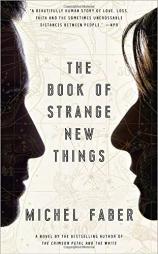The Book of Strange New Things
Review
The Book of Strange New Things
In an essay that accompanied the print version of his 1985 play “Aunt Dan and Lemon,” Wallace Shawn quoted the advice an older woman gave him when he was 13: “You don’t understand this now, but when you get older, you’ll come to appreciate the importance of comfort.” I didn’t fully appreciate it, either, and I was in my early 20s when I read this. But, as we all do, I soon learned the wisdom of this sentiment, as well as the many types of cushion one can use to blunt the impact of devastating experiences.
No one knows this better than Michel Faber, the author of the 2002 bestseller THE CRIMSON PETAL AND THE WHITE. As the New York Times reported on October 26th, Faber’s wife, Eva, was dying of cancer as he wrote his latest novel, THE BOOK OF STRANGE NEW THINGS. She passed away in July. One can understand Faber’s passion for this book, which he says will be his final novel. The search for comfort and meaning in the face of trying circumstances is among its major themes.
The new novel is set in the not-too-distant future. Peter and Beatrice Leigh are a young English couple on their way to Heathrow. Both are born-again Christians. As Faber tells us many times throughout this 500-page book, Peter has a checkered past. Before he found God, he was a thief who did a lot of drugs and alcohol. In one of the novel’s wittier exchanges, Peter says that he earned a degree in Toilet Bowl Interior Decoration.
"[M]any of the scenes in THE BOOK OF STRANGE NEW THINGS are compelling, especially late in the book. And Faber’s ability to conjure strange new worlds remains impressive. How sad that a gifted storyteller who has done such fine work in the past has decided not to write anymore."
Peter is about to catch a flight to Orlando, from which he travels to a distant planet called Oasis. He has been hired by a corporation known only by an acronym, USIC, to be a Christian missionary to the planet’s natives. Peter, wrapped in a gauzy loincloth, blacks out during the long ride to Oasis. When he comes to, he is greeted by two of the company’s employees: Tuska, the pilot; and BG (short for Billy Graham), a black man who is one of USIC’s engineers.
Peter meets others at USIC’s headquarters, including Grainger, a 30ish woman who delivers pharmaceuticals to the Oasans --- the name for Oasis’s indigenous population --- and drives him to the camp in which the Oasans live. Soon, Peter is setting up a mission for the natives, who tell him, in a dialect Faber occasionally renders unreadable with his use of made-up characters, that they are hungry for the word of God.
His only communication with Bea is through a computer-like device called the Shoot. When Peter tells her about his experiences with the Oasans, Bea responds with bad news from Earth, from the crumbling marriage of a Muslim acquaintance to tidal waves in the Maldives and a Congressman who shot his wife in the head. As Peter learns more about the Oasans and the real reason for the USIC settlement, the mounting atrocities on Earth shake Bea’s faith in God and, when Peter’s messages become less frequent, in her husband.
It’s hard to write a review of this novel given the news about Faber’s wife. I can imagine how painful the writing of it must have been. That emotional state may have led him to some of the excesses in the book, such as the many long messages Peter writes to Bea to share information the reader has already learned. There are, alas, other weaknesses. The title of each chapter is the chapter’s last line, a gimmick that wears thin quickly. And there’s not enough tension here to justify the novel’s length, an absence that makes stylistic tics more prominent. Characters walk toward silos for 10, 20 minutes or drive for five, 10 minutes or wear a dress 20, 30 times. Faber frequently mentions ablutions and bodily fluids. Peter is often naked, a criticism that has nothing to do with prudishness and everything to do with the book’s repetitiveness.
However, many of the scenes in THE BOOK OF STRANGE NEW THINGS are compelling, especially late in the book. And Faber’s ability to conjure strange new worlds remains impressive. How sad that a gifted storyteller who has done such fine work in the past has decided not to write anymore. The book’s publisher was quoted in the Times as saying, “I’m not ready to accept that he’s done.” I’m not, either.
Reviewed by Michael Magras on October 29, 2014
The Book of Strange New Things
- Publication Date: June 30, 2015
- Genres: Fiction
- Paperback: 528 pages
- Publisher: Hogarth
- ISBN-10: 0553418866
- ISBN-13: 9780553418866




